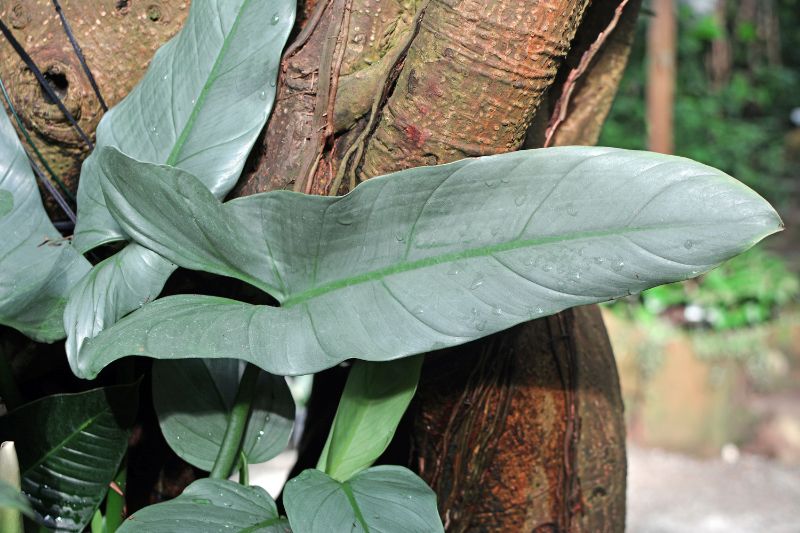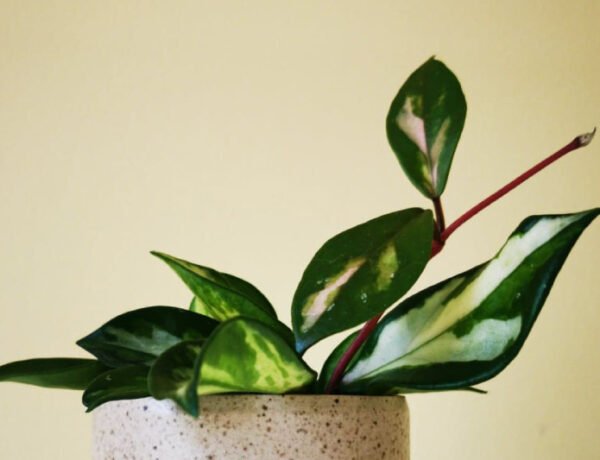If you’re into plants that change their shape while they mature, you’ll fall head over heels for the Silver Sword Philodendron.
You see, this isn’t just a “what you see is what you get” kind of plant. Nope, the Silver Sword goes through a stunning transformation as it grows. Its leaves, which start off as adorable, roundish forms, take on a long, sword-like shape as the plant reaches maturity. It’s like having two plants in one!
Originating from the endangered terrains of Brazil, this hard-to-resist greenie has made a cozy home in living rooms from all around the world. Ready to find out how to make your Silver Sword dazzle?
Let’s get this botanical party started!
Table of Contents
1. General Information & Taxonomy
| Scientific name: | Philodendron hastatum |
| Common names: | Silver Sword Philodendron |
| Native to: | Southeast Region of Brazil (Rio de Janeiro and Minas Gerais states) |
| Toxicity: | Toxic to humans and pets |
| Mature size: | Up to 10 feet tall, 6 feet wide |
| Category: | Upright growing Philodendron variety, endangered in native habitat |
| Growth Rate: | Moderate |
| Hardiness: | USDA hardiness zones 9b to 11 |

2. Silver Sword Philodendron Care & Growing Requirements
» Watering
Silver Sword Philodendrons love a good drink but don’t want to be soaked. Water when the top inch of the soil feels dry to the touch. Too much or too little water can make those stunning leaves droop, so keep an eye on that.
» Light
As for sunlight, Silver Sword is pretty flexible. It thrives in bright, indirect light but can tolerate lower light conditions.
Direct sunlight, though? A big no-no—that’s a quick ticket to burnt leaves.
» Soil
Choose a soil rich in organic matter with good drainage for your Silver Sword Philodendron, as it doesn’t like sitting in waterlogged soil.
For those of you who love DIY, mix in sphagnum moss and perlite for a dreamy custom blend.
» Temperature
Room temperature is just fine. Aim for a range between 65°F to 80°F (18-26°C). Not a fussy plant, right?
» Humidity
Aim for a humidity level between 50 to 75%. If the air’s too dry, a pebble tray or frequent misting will keep your Silver Sword happy.
» Fertilizer
During its growing season, from spring to summer, you can give your plant a little nutrient boost with balanced fertilizer. Just don’t overdo it!
3. Silver Sword Philodendron Maintenance and Propagation
» Repotting
You’ll know it’s time to repot your Silver Sword when those roots start making a surprise appearance from the bottom of the pot or even at the surface of the soil. Size up by about 2 inches for the new pot, and don’t forget those all-important drainage holes. This gives your plant room to stretch its roots and get comfy.
🌱 Pro tip: Add a moss pole to the new pot. It’ll give your P. hastatum something to climb and make it feel like it’s back in its natural habitat. Plus, it looks pretty snazzy!
» Pruning
If your Silver Sword is getting a bit too lush and is practically taking over the living room, or if you spot yellowing or damaged leaves, it’s time for a haircut. Use sterilized shears and cut right above the nodes to encourage fresh, bushier growth. After all, who doesn’t want a fuller, more fabulous plant?
» Propagation
Feeling generous? Or perhaps you just want to double the beauty in your space? Propagation has got you covered! Snip off a stem segment with at least two nodes and a couple of leaves, pop it into a glass of water, and play the waiting game. Usually, within a month, you’ll see roots and can transfer it to soil. Just remember to use sterilized shears to keep things healthy and happy.
Check out our article on ways to propagate a philodendron plant for more info!
5. Common issues & How to Deal With Them
Even the best of us run into some hiccups along the way. Here are some common issues you might encounter while caring for your Silver Sword Philodendron:
- Leaves Turning Yellow: If you’re seeing more than one yellow leaf at the same time, your P. hastatum might be sending out an SOS. Check the light and humidity, stat!
- Leaves Turning Brown: Brown tips? Probably a sign you should reevaluate the amount of light your plant is getting.
- Discolored Leaves: Mismatched colors can be a clue that you’re either overwatering or under-watering. It could also mean you’re overdoing it with the fertilizer.
- Leaves Dropping Off: If your philodendron leaves are falling faster than autumn in a New England postcard, it might be a humidity or watering issue. Double-check both to make sure you’re not too heavy-handed with the H2O or neglecting to keep the air moist enough.
- Stunted Growth: If your Silver Sword is more of a Silver Dagger, the likely culprit is poor soil nutrition or inadequate light.
- Leaf Curl: This can often be a sign of underwatering or too much direct sunlight. The plant’s way of saying, “Help, I’m thirsty!” or “Yikes, I’m burning!”
6. Philodendron Silver Sword Diseases & Pests
These plants are quite resistant to pests, but keep an eye out for the usual suspects like spider mites and mealybugs. If you see any, treat with neem oil or insecticidal soap.
Conclusion
So there you have it, folks! From its silver-hued, sword-shaped leaves to its easygoing nature, the Silver Sword Philodendron is a prime pick for both seasoned gardeners and newbie plant parents. With just a bit of love, attention, and the right conditions, this resilient plant can be the show-stopping centerpiece of your indoor jungle.
If you’re enamored with this species, you might also be interested in exploring other types of philodendrons. Check out our list of Philodendron varieties for more exciting options.
Looking for more plants that stand tall and proud? Don’t miss our curated list of tall houseplants that will make a grand statement in any space.
Or maybe you’ve caught the bug for foliage in unique hues? You’ll want to read our article on plants with blue leaves to add an unexpected pop of color to your collection.
Remember, the plant world is your oyster, and each new addition to your green family brings a unique set of joys and challenges. As always, your journey to becoming a plant whisperer should be filled with love, leafy greens, and a little bit of soil under your fingernails.






No Comments